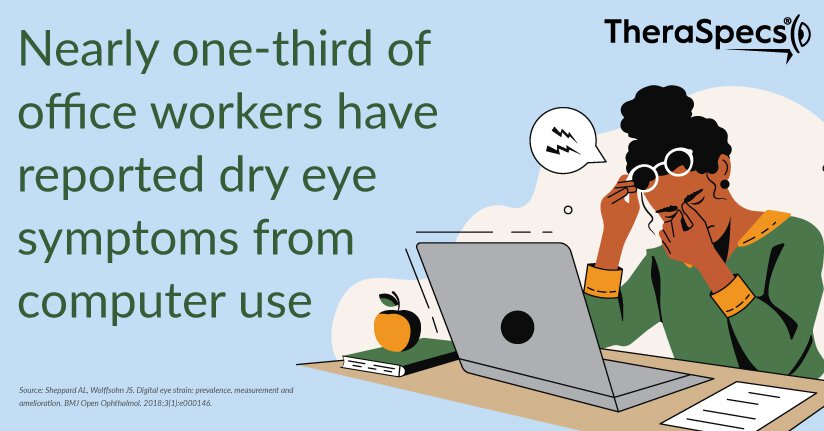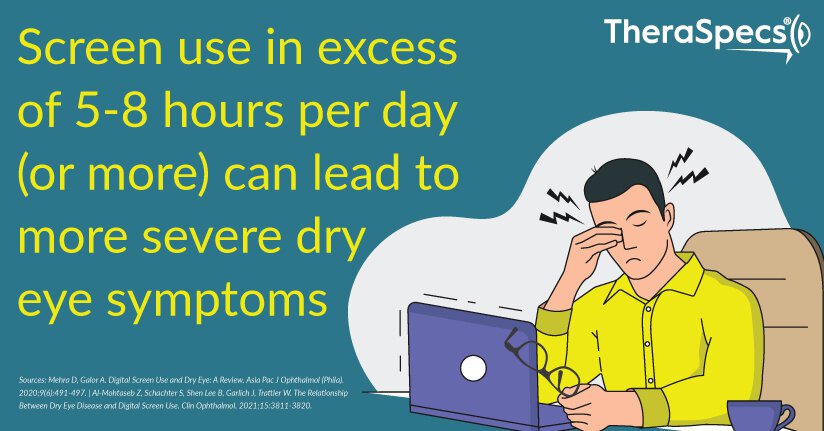Dry Eye and Screen Time: How Devices Can Affect Healthy and Light-Sensitive Eyes
The effects that digital screens have on our eyes and brain can be vast, from instigating acute (and often temporary) pain for healthy people to aggravating light-sensitive conditions like migraine and post-concussion syndrome. Dry eye is another condition associated with light sensitivity and can be greatly impacted by screen time. We examine how screens can wreak havoc on those prone to dry eyes.
How Do Screens and Screen Time Affect Dry Eye?
Millions of people know what it feels like to have dry eyes after working too long on the computer and/or looking at a smartphone device. In fact, dry eyes are frequently one of many physiological symptoms that can result from digital eye strain and computer vision syndrome. According to a survey by The Vision Council, nearly 60% of American adults have reported the negative effects of excessive screen time, with dry eyes affecting one in four respondents.
Another study showed that more than 30% of office workers had dry eye symptoms as a result of using the computer.1 In particular, experts have suggested that dry eye was the root cause for a constellation of physical complaints associated with digital eye strain, including:
- Headaches
- Sensitivity to light
- Itchy eyes
- Eye pain and burning

It is also important to distinguish between temporary symptoms of dry eye and dry eye disease (DED). Some people have a chronic or recurring issue where they are unable to produce enough tears for proper eye health, and the use of any screens—let alone overexposure to them—has been linked to higher rates of dry eye disease.2
Others who have migraine or suffered a traumatic brain injury are more susceptible to the complications of dry eye, and screen time consistently has been reported as a “trigger” for their symptoms.3-4 And there are literally dozens of conditions that can be aggravated by screen light and may also lead to dry, irritated or inflamed eyes.
How Much Screen Time is Too Much for Dry Eye?
The amount of time we use our devices also plays a critical role in the likelihood of dry eye symptoms, and several studies have attempted to quantify the number of hours that might be considered “excessive.” This research has shown that people who are exposed to their screens for more than 5-8+ per day had increasingly negative outcomes, such as a higher prevalence of diagnosed dry eye disease and more severe symptoms.5-6

In addition, the type and number of total dry eye-related symptoms were heavily influenced by increasing amounts of screen time, particularly for younger adults. More hours of exposure led to more headaches, eye redness and rubbing, and patients generally cited more symptoms overall with an average of nearly three.7 The significant rise in digital device usage during the COVID-19 pandemic seems to have worsened eye health for many people as well.
The raw number of hours on your screen does not tell the whole story though. The specific purpose or activity can impact the eye complications that result. For example, just two hours of so-called “high intensity” smartphone usage (e.g. continuous reading) was enough to substantially increase the severity of dry eye symptoms, among other signs.8 Furthermore, there may be a cumulative effect as well. Constant screen time over the course of 8-12+ years seems to be more harmful when compared with those who have been working on digital screens for four years or fewer.6
As if that were not enough, when you use your device screens also matters. In particular, screen time right before bed can hasten the onset of dry and irritated eyes.9 This is consistent with other research that suggests that blue light exposure (especially before bedtime) can negatively harm our brains and affect our circadian rhythm—thus resulting in neurological symptoms, disrupted sleep, and reduced productivity. To help with this, you can try orange-tinted sleep glasses that block 100% of blue light while you use your devices at night.
Why and How Does Screen Time Lead to Dry Eye?
There are a variety of possible reasons why our screens can leave our eyes in so much pain and discomfort. As we mentioned previously, the blue light emitted from our computers and smartphones can trigger the symptoms we experience.
For individuals with light sensitivity or a related condition, specific wavelengths of blue light (near 480nm) can bring about the irritation and dryness in their eyes—especially given the connections between light-sensitive disorders like migraine and dry eye disease. They also have a lower tolerance for bright light, which can negatively activate parts of their brain as well as force their eyes to strain while using a device. Certain blue light can also lead to ocular damage even for healthy eyes.
Another big reason why the eyes can experience discomfort due to screen use stems from the rate of blinking. Studies have shown that people simply blink less often while using their screens, particularly during tasks that require greater concentration, which affects tear production. Perhaps even more impactful is the rate of “incomplete” blinking, where the upper eyelid does not fully cover the eye, thus preventing proper moisture from circulating around the eye.1
Other environmental factors can factor into the equation too. Improper viewing distance, lack of ambient lighting, and poor air quality are just some of the complicating elements that might affect our eyes while viewing a screen.
How Can You Prevent and Relieve Screen-Related Dry Eye?
Several strategies can help people prevent the onset of dry eyes or at least lower the risk that they will develop. These include:
Reduce blue light exposure: Even a 20% reduction in total exposure to blue light can improve eye dryness and tear function, and the benefits are even more powerful for decreasing blue light at 480nm if you are already sensitive to light.10 TheraSpecs are a specific brand of therapeutic eyewear that offers a variety of lens options targeting exactly the right wavelengths to provide optimal protection for dry eye and blue light sensitivity. This includes several FL-41 products that remove triggering blue light near 480nm, Sleep glasses that eliminate 100% of all blue light, and yellow-tinted glasses that focus on cutting out high-energy blue wavelengths that impact vision and contrast. They also have an impressive track record as an effective tool for screens among those with photophobia, particularly in comparison to other remedies.
Implement 20-20-20 rule: One of the most effective strategies is also one of the simplest. Eye doctors and experts consistently recommend taking a 20-second break for every 20 minutes of screen viewing in order to look at something 20 feet away. This can allow the eyes to relax, potentially increase proper blinking, and help diminish the effects of digital eye strain.
Try blinking exercises: Many eye care professionals will suggest a variety of blinking exercises to facilitate more full blinks and help manage your dryness symptoms. Plus, research has supported their alleviating benefits.5
Reduce total screen time: Sometimes you just need to give your eyes a break for more than a few minutes. For example, younger persons have benefitted from the complete removal of their screen time for as much as four weeks. Although there can be negative social consequences and it may be more difficult for adults to implement such a strategy, it does illustrate that behavioral modifications can have a positive effect.
Improve environmental factors: Increasing the humidity in the environment—with a humidifier for example—can help keep the eyes moist. Also, setting up a proper viewing distance and angle for screen use can further enable you to comfortably view your devices without strain.
General dry eye treatments: For persistent and/or severe symptoms, there are a wide array of treatment options and medications that can help with inflammation, dryness and tear production. Consulting with your doctor is always a great first step to identifying what might work for you and the most appropriate course of action.
We hope these tips allow you to use your devices with less pain!
More Reading: The Impact of Screens and Digital Devices
Computer Screens: The Effect on Headaches, Migraines and Concussions
Here's Why Smartphones Can Hurt Our Eyes and Cause Headaches
Screen Time after a Concussion: Should You Limit Use of Electronics?
References:
1Sheppard AL, Wolffsohn JS. Digital eye strain: prevalence, measurement and amelioration. BMJ Open Ophthalmol. 2018;3(1):e000146. Published 2018 Apr 16. doi:10.1136/bmjophth-2018-000146
2Hikichi T, Yoshida A, Fukui Y, et al. Prevalence of dry eye in Japanese eye centers. Graefes Arch Clin Exp Ophthalmol. 1995;233(9):555-558. doi:10.1007/BF00404705
3Ismail OM, Poole ZB, Bierly SL, et al. Association Between Dry Eye Disease and Migraine Headaches in a Large Population-Based Study. JAMA Ophthalmol. 2019;137(5):532-536. doi:10.1001/jamaophthalmol.2019.0170
4Lee CJ, Felix ER, Levitt RC, et al. Traumatic brain injury, dry eye and comorbid pain diagnoses in US veterans. Br J Ophthalmol. 2018;102(5):667-673. doi:10.1136/bjophthalmol-2017-310509
5Mehra D, Galor A. Digital Screen Use and Dry Eye: A Review. Asia Pac J Ophthalmol (Phila). 2020;9(6):491-497. doi:10.1097/APO.0000000000000328
6Al-Mohtaseb Z, Schachter S, Shen Lee B, Garlich J, Trattler W. The Relationship Between Dry Eye Disease and Digital Screen Use. Clin Ophthalmol. 2021;15:3811-3820. Published 2021 Sep 10. doi:10.2147/OPTH.S321591
7Wu SZ, Chong JK, Tracer N, Wu M, Raju L. Prevalence of dry eye symptoms and relationship to screen time in a New York City pediatric population. Investigative Ophthalmology & Visual Science. 2020;61:340. Accessed May 6, 2022. https://iovs.arvojournals.org/article.aspx?articleid=2766486
8Wang C, Yuan K, Mou Y, Wu Y. High-Intensity Use of Smartphone Can Significantly Increase the Diagnostic Rate and Severity of Dry Eye. Huang J, ed. Front Med. Published online April 26, 2022. Accessed May 6, 2022. https://www.frontiersin.org/articles/10.3389/fmed.2022.829271/full
9Mineshita Y, Kim HK, Chijiki H, et al. Screen time duration and timing: effects on obesity, physical activity, dry eyes, and learning ability in elementary school children. BMC Public Health. 2021;21(1):422. Published 2021 Feb 28. doi:10.1186/s12889-021-10484-7
10Kaido M, Toda I, Oobayashi T, Kawashima M, Katada Y, Tsubota K. Reducing Short-Wavelength Blue Light in Dry Eye Patients with Unstable Tear Film Improves Performance on Tests of Visual Acuity. PLoS One. 2016;11(4):e0152936. Published 2016 Apr 5. doi:10.1371/journal.pone.0152936
Last updated 13th Mar 2024
TheraSpecs Glasses for Light Management
Try our light-filtering glasses and stay protected against harsh light from screens, fluorescents, LEDs, unwanted blue light, bright sunlight, flashing lights, and more.





